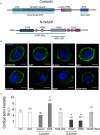The F-Actin Binding Protein Cortactin Regulates the Dynamics of the Exocytotic Fusion Pore through its SH3 Domain
- PMID: 28522963
- PMCID: PMC5415606
- DOI: 10.3389/fncel.2017.00130
The F-Actin Binding Protein Cortactin Regulates the Dynamics of the Exocytotic Fusion Pore through its SH3 Domain
Abstract
Upon cell stimulation, the network of cortical actin filaments is rearranged to facilitate the neurosecretory process. This actin rearrangement includes both disruption of the preexisting actin network and de novo actin polymerization. However, the mechanism by which a Ca2+ signal elicits the formation of new actin filaments remains uncertain. Cortactin, an actin-binding protein that promotes actin polymerization in synergy with the nucleation promoting factor N-WASP, could play a key role in this mechanism. We addressed this hypothesis by analyzing de novo actin polymerization and exocytosis in bovine adrenal chromaffin cells expressing different cortactin or N-WASP domains, or cortactin mutants that fail to interact with proline-rich domain (PRD)-containing proteins, including N-WASP, or to be phosphorylated by Ca2+-dependent kinases, such as ERK1/2 and Src. Our results show that the activation of nicotinic receptors in chromaffin cells promotes cortactin translocation to the cell cortex, where it colocalizes with actin filaments. We further found that, in association with PRD-containing proteins, cortactin contributes to the Ca2+-dependent formation of F-actin, and regulates fusion pore dynamics and the number of exocytotic events induced by activation of nicotinic receptors. However, whereas the actions of cortactin on the fusion pore dynamics seems to depend on the availability of monomeric actin and its phosphorylation by ERK1/2 and Src kinases, cortactin regulates the extent of exocytosis by a mechanism independent of actin polymerization. Together our findings point out a role for cortactin as a critical modulator of actin filament formation and exocytosis in neuroendocrine cells.
Keywords: N-WASP; actin polymerization; catecholamines; chromaffin cells; cortactin; exocytosis; fusion pore; neuroendocrine cells.
Figures






Similar articles
-
Src kinases regulate de novo actin polymerization during exocytosis in neuroendocrine chromaffin cells.PLoS One. 2014 Jun 5;9(6):e99001. doi: 10.1371/journal.pone.0099001. eCollection 2014. PLoS One. 2014. PMID: 24901433 Free PMC article.
-
Erk/Src phosphorylation of cortactin acts as a switch on-switch off mechanism that controls its ability to activate N-WASP.Mol Cell Biol. 2004 Jun;24(12):5269-80. doi: 10.1128/MCB.24.12.5269-5280.2004. Mol Cell Biol. 2004. PMID: 15169891 Free PMC article.
-
Differential regulation of cortactin and N-WASP-mediated actin polymerization by missing in metastasis (MIM) protein.Oncogene. 2005 Mar 17;24(12):2059-66. doi: 10.1038/sj.onc.1208412. Oncogene. 2005. PMID: 15688017
-
Two pathways control chromaffin cell cortical F-actin dynamics during exocytosis.Biochimie. 2000 Apr;82(4):339-52. doi: 10.1016/s0300-9084(00)00193-0. Biochimie. 2000. PMID: 10865122 Review.
-
Regulation of actin filament network formation through ARP2/3 complex: activation by a diverse array of proteins.Annu Rev Biochem. 2001;70:649-76. doi: 10.1146/annurev.biochem.70.1.649. Annu Rev Biochem. 2001. PMID: 11395419 Review.
Cited by
-
Isolation and Purification of Chromaffin Granules from Adrenal Glands and Cultured Neuroendocrine Cells.Methods Mol Biol. 2023;2565:283-296. doi: 10.1007/978-1-0716-2671-9_19. Methods Mol Biol. 2023. PMID: 36205901
-
How does the stimulus define exocytosis in adrenal chromaffin cells?Pflugers Arch. 2018 Jan;470(1):155-167. doi: 10.1007/s00424-017-2052-5. Epub 2017 Aug 29. Pflugers Arch. 2018. PMID: 28852855 Review.
-
The role of F-actin in the transport and secretion of chromaffin granules: an historic perspective.Pflugers Arch. 2018 Jan;470(1):181-186. doi: 10.1007/s00424-017-2040-9. Epub 2017 Jul 20. Pflugers Arch. 2018. PMID: 28730385 Free PMC article. Review.
-
Wasl is crucial to maintain microglial core activities during glioblastoma initiation stages.Glia. 2022 Jun;70(6):1027-1051. doi: 10.1002/glia.24154. Epub 2022 Feb 22. Glia. 2022. PMID: 35194846 Free PMC article.
-
Advances in Exosome-Based Therapies for the Repair of Peripheral Nerve Injuries.Neurochem Res. 2024 Aug;49(8):1905-1925. doi: 10.1007/s11064-024-04157-1. Epub 2024 May 28. Neurochem Res. 2024. PMID: 38807021 Review.
References
-
- Alés E., Tabares L., Poyato J. M., Valero V., Lindau M., Alvarez de Toledo G. (1999). High calcium concentrations shift the mode of exocytosis to the kiss-and-run mechanism. Nat. Cell Biol. 1 40–44. - PubMed
LinkOut - more resources
Full Text Sources
Other Literature Sources
Miscellaneous

